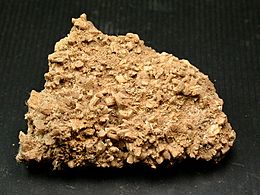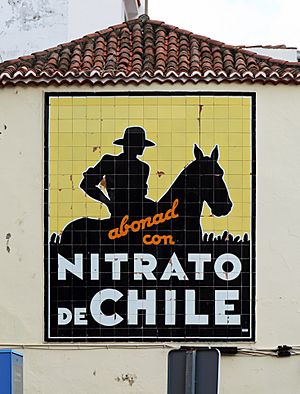Nitratine facts for kids
Quick facts for kids Nitratine |
|
|---|---|
 |
|
| General | |
| Category | Nitrate minerals |
| Formula (repeating unit) |
NaNO3 |
| Strunz classification | 5.NA.05 (10th edition) 5/A.01-10 (8th edition) |
| Crystal symmetry | R3c (no. 167) |
| Unit cell | a = 5.06 Å, c = 16.82 Å; Z = 6 |
| Identification | |
| Formula mass | 84.99 g/mol |
| Color | Colorless, White, Gray, Yellowish, Brownish |
| Crystal habit | Granular - Generally occurs as anhedral to subhedral crystals in matrix; Massive - Uniformly indistinguishable crystals forming large masses |
| Crystal system | Trigonal |
| Cleavage | {1011} Perfect |
| Tenacity | Sectile - curved shavings or scrapings produced by a knife blade |
| Mohs scale hardness | 1.5 - 2 |
| Luster | Vitreous (Glassy) |
| Streak | White |
| Diaphaneity | Transparent |
| Specific gravity | 2.26 |
| Optical properties | Uniaxial (-) |
| Refractive index | nω = 1.580 - 1.587 nε = 1.330 - 1.336 |
| Birefringence | δ = 0.250-0.251 |
| Solubility | Readily soluble in water |
| Other characteristics | Slightly deliquescent |
Nitratine is a natural mineral. It is also known by other names like soda niter or Chile saltpeter. This mineral is the natural form of sodium nitrate, which has the chemical formula NaNO3.
Nitratine is quite soft, with a Mohs hardness of 1.5 to 2. This means you could scratch it easily with your fingernail. It is also light, with a specific gravity of about 2.26.
You usually find nitratine as white, gray, or yellowish-brown coatings. It rarely forms clear crystals. Nitratine is very soluble in water. This means it dissolves easily. It is also deliquescent, which means it absorbs water from the air. If left in humid air, it can turn into a puddle of sodium nitrate solution.
Nitratine is found in very dry places around the world. Large deposits are in countries like Chile, Mexico, Egypt, Peru, and South Africa. Chile is the only country that sells its nitratine commercially. About 600,000 tons of nitratine are mined in Chile each year. Other minerals like iodine are also found and mined there.
Nitratine is similar in structure to calcite, which is a common mineral. This similarity makes nitratine useful for scientists. They can use it to study how minerals dissolve and form under different conditions.
Historically, control over saltpeter deposits led to conflicts. For example, the War of the Pacific (1879-1884) was fought over these valuable mineral resources.
What is Nitratine Used For?
Nitratine was once a very important source of nitrates. Nitrates are chemicals used in fertilizer and for other industrial purposes. It was also used to make fireworks. Large deposits were discovered in the Atacama Desert in Chile and in Death Valley, California, in 1845.
Today, nitratine is still used in organic farming in the United States. However, it is not allowed in international organic agriculture. This is because other methods of producing nitrates are preferred.
This mineral has many uses beyond farming. It is used in the explosives industry for certain types of explosives. The glass and enamel industries use nitratine to remove air bubbles. It helps make these materials clearer and smoother.
Nitratine can also be used in solar technology. It helps transfer or store heat from the sun. It can also be a substitute for potassium nitrate in making gunpowder.
How is Synthetic Sodium Nitrate Made?
After World War I, there was a great need for cheaper ways to make fertilizer. This led to the creation of synthetic (man-made) nitratine. This process was much cheaper than mining and refining natural nitratine.
Scientists found a way to make sodium nitrate using gases from nitric acid plants. They combined these gases with solutions of sodium carbonate or sodium hydroxide. Through a series of chemical reactions, they could produce sodium nitrate. This method also created other useful byproducts.
See Also
 In Spanish: Nitratina para niños
In Spanish: Nitratina para niños
- Fertilizer
- Mining in Chile
- Niter
- Nitrate
- Nitric Acid
- Nitrogen Cycle
- Potassium nitrate
- Sodium hydroxide


